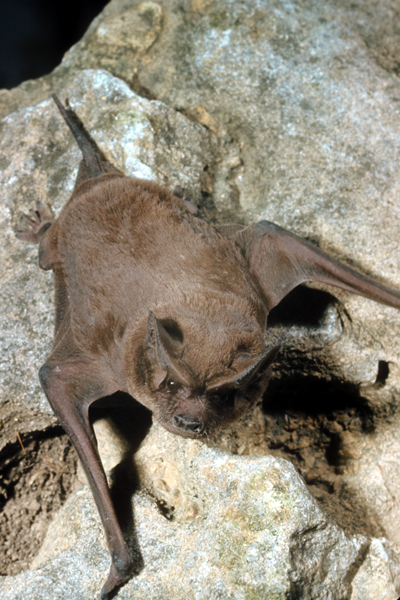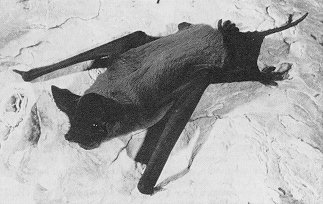
Reproduction
The Tadarida brasiliensis as a species change their behavior and scent- markers throughout the year depending on the breeding season (Sosnicki, 2012). Few adult males return northward in spring and mating occurs in lover latitudes of the winter season after migration has occurred. For males, they reach sexual maturity during their second year compared to females who reach sexual maturity at nine months. (Wilkins, 1989) The females have one estrus per breeding season that lasts for about five weeks during ovulation usually in the spring (also known as monestrous). These bats are polygynandrous which means that the females pair with multiple males each of whom also pair with multiple females. Females give birth to a single offspring only during the eleven to twelve week gestation period (Sosnicki, 2012).
Click here for more information regarding reproduction
 These bat births occur upside down and rather quickly only lasting
about ninety seconds. During the labor passage through the birth
canal the mother shreds the amnion with the claws from her feet. The
mother does not use her flight membranes (wings and claws) to bring
out the newborn (Wilkins, 1989). The young are born in an
underdeveloped state known as altricial where they are unable to
feed or care for themselves for a period of time after birth. The
newborns are on average 25.8 mm long from the posterior to anterior.
The skin is smooth and slightly pigmented. They are hairless except
near their toes and thumbs. After giving birth there is an
additional ten to fifteen minutes that the pup needs to find the
nipple for feeding. These females have the highest milk fat content
of any bat at 28 percent which, allows the pups to grow relatively
quickly (Sosnicki, 2012). The placenta passes through the canal
about two hours after giving birth and it remains attached to the
newborn till the chord dries up and breaks off in about two days
(Wilkins, 1989). The sex-ratio is about 1:1 at birth with the pups
in the population.
These bat births occur upside down and rather quickly only lasting
about ninety seconds. During the labor passage through the birth
canal the mother shreds the amnion with the claws from her feet. The
mother does not use her flight membranes (wings and claws) to bring
out the newborn (Wilkins, 1989). The young are born in an
underdeveloped state known as altricial where they are unable to
feed or care for themselves for a period of time after birth. The
newborns are on average 25.8 mm long from the posterior to anterior.
The skin is smooth and slightly pigmented. They are hairless except
near their toes and thumbs. After giving birth there is an
additional ten to fifteen minutes that the pup needs to find the
nipple for feeding. These females have the highest milk fat content
of any bat at 28 percent which, allows the pups to grow relatively
quickly (Sosnicki, 2012). The placenta passes through the canal
about two hours after giving birth and it remains attached to the
newborn till the chord dries up and breaks off in about two days
(Wilkins, 1989). The sex-ratio is about 1:1 at birth with the pups
in the population.
Parental care is carried out by the females including
protection, weaning, and provisioning. Mothers do not roost with their newborn offspring and
instead leave the pups with a large cluster of other pups called a
creche. When trying to find her pup the mother will have to identify
her own young with a series of calls and odors that the pup produces
(Sosnicki, 2012). It has been found that the
scent from the mothers is imprinted during early stages of
development making it easier for the mother to find her offspring.
While in the cluster though the pup will try to latch onto any
female passing by to be fed. The young bats are nursed daily,
usually twice (Sosnicki, 2012). Although the mothers do not carry
their young during flight, they will carry their young during
disturbances in the roost (Wilkins, 1989). Four to seven weeks after
birth, the young pups have reached adult size and are left to be
independent.
provisioning. Mothers do not roost with their newborn offspring and
instead leave the pups with a large cluster of other pups called a
creche. When trying to find her pup the mother will have to identify
her own young with a series of calls and odors that the pup produces
(Sosnicki, 2012). It has been found that the
scent from the mothers is imprinted during early stages of
development making it easier for the mother to find her offspring.
While in the cluster though the pup will try to latch onto any
female passing by to be fed. The young bats are nursed daily,
usually twice (Sosnicki, 2012). Although the mothers do not carry
their young during flight, they will carry their young during
disturbances in the roost (Wilkins, 1989). Four to seven weeks after
birth, the young pups have reached adult size and are left to be
independent.